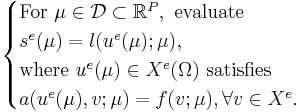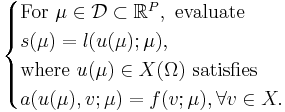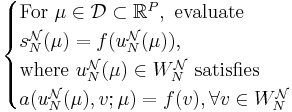| Line 68: | Line 68: | ||
<math> V_1 \subset V_2 \subset ... \subset V_{N_{max}} </math>. |
<math> V_1 \subset V_2 \subset ... \subset V_{N_{max}} </math>. |
||
| + | |||
| + | We then consider the galerkin projection onto the RB-space <math> V_N </math> |
||
| + | |||
| + | <math> |
||
| + | \begin{cases} |
||
| + | \text{For } \mu \in \mathcal{D} \subset \mathbb{R}^P, \text{ evaluate } \\ |
||
| + | s_N^\mathcal{N}(\mu) = f(u_N^\mathcal{N}(\mu)), \\ |
||
| + | \text{where } u_N^\mathcal{N}(\mu) \in W_N^\mathcal{N} \text{ satisfies } \\ |
||
| + | a(u_N^\mathcal{N}(\mu),v;\mu) = f(v), \forall v \in W_N^\mathcal{N} |
||
| + | \end{cases} |
||
| + | </math> |
||
==Time-Dependent PDEs== |
==Time-Dependent PDEs== |
||
Revision as of 15:33, 19 November 2012
The Reduced Basis Method (RBM) we present here is applicable to static and time-dependent linear PDEs.
Time-Independent PDEs
The typical model problem of the RBM consists of a parametrized PDE stated in weak form with
bilinear form  and linear form
and linear form  .
The parameter
.
The parameter  is considered within a domain
is considered within a domain  and we are interested in an output quantity
and we are interested in an output quantity  which can be
expressed via a linear functional of the field variable
which can be
expressed via a linear functional of the field variable  .
.
The exact, infinite-dimensional formulation, indicated by the superscript e, is given by

We assume a large-scale discretization to be given, such that we consider

The underlying assumption of the RBM is that the parametrically induced manifold  can be approximated by a low dimensional space
can be approximated by a low dimensional space  .
.
It also applies the concept of an offline-online decomposition, in that a large pre-processing offline cost is acceptable in view of a very low online cost (of a reduced order model) for each input-output evaluation, when in a many-query or real-time context.
The essential assumption which allows the offline-online decomposition is that there exists an affine parameter dependence


The Lagrange Reduced Basis space is established by iteratively choosing Lagrange parameter samples

and considering the associated Lagrange RB spaces

in a greedy sampling.
This leads to hierarchical RB spaces:
 .
.
We then consider the galerkin projection onto the RB-space 

